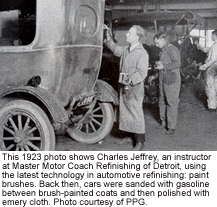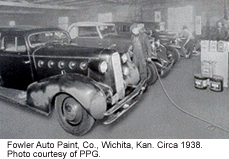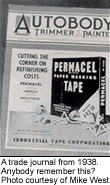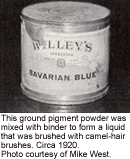One of the most interesting and incredible stories coming out of the industrial revolution of the last 100 years is the history of automotive paint.
Oh, I know, you’re probably thinking that’s about as interesting as watching grass grow or pond scum form on a sewage lagoon. Wrong! It’s an amazing story, filled with all the elements of a modem thriller; intrigue, accidents, politics and war all played a part in the development and history of automotive paint.
From Carriages to Cars
Most of us active in the collision repair and refinish industry forget that spraying wasn’t always the method used to paint automobiles. I’ve been in the industry since 1964. At that time, I was a student at the Emily Griffith Opportunity School in Denver, where we worked primarily with three finishes: nitrocellulose lacquer, acrylic lacquer and alkyd or synthetic enamel. I’m not going to delve into the technical aspects of each of these finishes, other than to say that the durability of each is vastly inferior to the wonderful finishes available today. But no matter how inferior the lacquers and synthetic enamel seem to those of us who’ve used both them and the new catalyzed products, they were more of an improvement over the previous finishes of the time than the paints of today were over their immediate predecessors. That’s an ambitious statement, since the polyurethanes and acrylic urethanes of today are a tremendous improvement over the lacquers and synthetic enamel of yesterday. Lifetime warranties are now commonplace, when before they were virtually non-existent.
But … the old lacquer and enamel finishes were a fantastic improvement over their brush-painted predecessors. Prior to 1924, vehicles were painted using the same carriage-builder method used for decades. Not familiar with that method? Check out this explanation of the paint process from an early advertisement of the Studebaker Brothers Carriage Manufacturing Company in South Bend, Ind.:
“Studebaker Finish! The most perfect, lasting surface of paint and varnish possible to put upon carriages. As the most vivid means of suggesting all the processes that culminate in a Studebaker finish, the accompanying panel was prepared. It illustrates the twenty-two successive stages of finish as they appear on every Studebaker carriage. But, there are other steps typical of Studebaker thoroughness that cannot be pictured: the chemists tests of oils and pigments; the careful preparation of the wood to take its finish properly; the repeated hand rubbing (sanding and polishing) to get smoothness; the perfect drying of the coats, an item that means fifty-two days of valuable time.
“More important than all of these, is the long, unequaled Studebaker experience, coupled with the thoroughgoing principles practiced throughout this 101 acre plant, from the executive office to forge, make it safe for us to lay bare these manufacturing policies — safe for you to trust the name of Studebaker — Studebaker Finish Endures.”
Can you imagine? Fifty-two days to paint a carriage! (Cycle times obviously weren’t important then!) Other documents I’ve found regarding various manufacturers weren’t much different. The drying times were extremely slow, and vast drying sheds of a very sanitary quality were employed to accomplish the task. But durability was poor. The Japan varnish topcoats succumbed to ultraviolet rays in two to three years.
When the automobile came along, it was little more than a motorized carriage. But the use of more sheet metal required the use of corrosion-resistant primers, primer surfacers and new sealers —so these new products were added to the centuries-old system already in practice. And this system was used to refinish the new and soon-to-be mass-produced automobile — a system that was woefully inadequate to the task at hand.

Oops! Oh, Wow, Look What I Invented
In the 1920s, several paint manufacturers were involved in the development of nitrocellulose lacquers. But one manufacturer in particular stands out. Have you ever heard someone say that many inventions come from mistakes? It’s true.
In 1921, DuPont was a leader in nitrate movie-film manufacturing.
“So what,” you say. “Did I skip a page or something?”
Keep reading. It’ll make sense soon enough.
Little did the company know it was about to discover how to unlock the massive painting bottleneck auto manufacturers were suffering from.
It happened on a hot Friday afternoon in July 1921, when a worker at the DuPont film plant left a drum of gun cotton (cotton fibers treated with a nitrate solution) out on a loading dock during the very warm weekend. Monday morning, concerned workers brought the drum inside and opened it up. To their amazement, what they found wasn’t gun cotton, but a clear, viscous liquid. This liquid became the foundation of nitrocellulose lacquer, which was the leading automotive finish for nearly 50 years.
Two years later, in 1923, the 1924 Oakland (a precursor of the Pontiac) was the first production automobile to be spray painted. Of course, many improvements had been made along the way in regard to force drying, application methods and product formula, but this initial discovery and subsequent use for spray painting unlocked the tremendous production improvement.
During the 1930s, both nitrocellulose lacquer and alkyd enamel were used in automobile production. Many manufacturers also used combinations, offering black enameled fenders and a selection of colored lacquer bodies. Chrysler, Ford, Nash, Willy’s and Studebaker used alkyd enamels on their offerings, while General Motors and many smaller independent manufacturers used lacquer. These products and their derivations were used well into the ’70s by both OEMs and the refinish industry.

The Europeans Kick Our Butt
I’ve often pondered why the Europeans came on so strong with basecoat technology and the development of acrylic urethane clear topcoats. What happened? Certainly our paint industry was no small player in research and development, and our automotive industry was a leader in production of mass-produced automobiles.
Let’s take a look:
At the end of World War II, the Axis powers in Europe were prohibited from using certain chemicals and substances in their manufacturing processes that could also be used to manufacture explosives. This made many of the components for nitrocellulose lacquer off limits. So what did they do? They focused on enamels.
With their usual flair for quality and characteristic genius, they developed a fantastic high-solids acrylic urethane paint system for automobiles. This system was extremely durable in comparison to the air-dry systems of lacquer or synthetic enamel that were commonly used in the 1980s — when the Europeans and their paint began a U.S. invasion.
Did the Europeans overwhelm the American competition immediately? Hardly. These European systems were just that, systems. They required strict, to-the-letter processes and forbade the mixing of one manufacturer’s product with another’s. By American standards, their systems were confusing. In terms of quality and durability, however, the Europeans were leading the pack. The American lacquers and acrylic enamels weren’t anywhere near the European’s systems.
During the late 1970s and early ’80s, the Europeans began campaigning their systems against American paint lines and started gaining U.S. market share. This forced a lot of change upon American manufacturers. And American collision repairers. We, in the shops, endured a lot of misery as the American manufacturers used us as field testers — aka, guinea pigs — for their “scurry to market” product lines.
I know. I Iived it.
A paint jobber sent my wife and me to Europe, where he wined and dined us for a week — all expenses paid. When we returned home, I decided to try a new line, produced by an American paint company. My jobber was peeved — especially after sending us to Europe — but I was convinced an American-made paint could compete against the foreign invaders. Boy, was I wrong at the time — and I paid for it for three years.
Back then, our paint companies just didn’t have a handle on what it took to make an acrylic urethane work. Dieback was a major problem, as was mottling. The basecoat would look nice, but after applying the clearcoat, the base would shift, causing mottling. When you had a paint representative examine the problem, he looked mystified.
These problems were pretty much universal among the American paint manufacturers as they tried to play catch up. Today, however, I believe our American paint companies have closed the gap in technology and produce excellent products — it just took several years to get here.

Mother Nature Makes Life Difficult
Environmental regulations were also a massive force for change in paint technology. Volatile organic compounds (VOCs), transfer efficiency, high-solids paint, catalyzed primers and federal air standards were just some of the new vocabulary we had to learn. Problem was, the refinish industry was playing catch up as legislation outstripped technology. How could we meet these seemingly very difficult standards and remain solvent? Was the answer in the paint or the equipment? Everybody seemed to be pointing their fingers at everyone but themselves.
Shops that were forced to meet strict air-quality standards regarding emissions didn’t want to purchase expensive after-burner technology to meet these standards. So they pointed the finger at the paint manufacturers and said, “Give us regulation-compliant products so we don’t have to purchase this expensive equipment.”
Paint manufacturers pointed at the equipment manufacturers and said, “Produce a spray gun that transfers our product to the car instead of the air.”
Round and round we went.
Field testing the shops was, again, rampant — and so were re-dos. Now the paint gun manufacturers were playing the same game of catch up as the paint manufacturers. And so were collision repairers. We bought spray gun after spray gun, trying this one and that one. None seemed to atomize the new EPA-compliant products worth a damn. It was chaotic.
Though many shop owners were adamantly opposed to regulations, some of us thought they might be a tool to upgrade the industry and drive out hackers. We also thought that getting involved in the formulation of the regulations might help us get something we could live with.
Things began to smooth out in the mid-’80s, as we all began to max out the learning curve. The ’90s have been much calmer. Federal regulations continue to force paint manufacturers to alter their products to achieve compliance, but these changes are usually overcome in a matter of weeks or months rather than years.

Funky Flakes and Psychedelic Effects
Hobbyists or hot-rodders have been adding special flakes to their colors for years — years before OEM car manufacturers offered them on production cars. But ever since OEMs determined that people like the flake effect and that their factories could produce it without the hundreds of labor hours the street rodder spent creating his, paint on production vehicles has gotten funkier — and flakier.
Flakes have been around for decades, but it wasn’t until the 1950s that Alcoa developed an aluminum flake for use in automotive paints. These flakes were brighter, larger and more similar in size to each other than the previous offerings. Stylists at Ditzler (now PPG) coined the term “poly-chromatic” to describe a color with many facets.
The ’60s saw really large, flamboyant, vinyl flakes that required a higher-solids resin to carry them and many coats of clear to cover them. While many street rodders relished the opportunity to spend hours sanding and polishing, OEMs never put them on production vehicles because of the cost and production complexity.
In the 1970s, Chrysler incorporated mica reflectants into its paint. Aluminum flake is like a mirror, polished on two sides but dark on the edge. Mica, however, is like a prism — some light is reflected and some is transmitted. And coating a mica flake with titanium powder yields a pigment that mimics pearlescence.
Improvements in clears played a huge part in making snazzy paint jobs available from OEMs. Once the solids level in clears went up sufficiently to support reflectants, the next step was to improve UV resistance. The real advances were made when we could create a clear clearcoat that would withstand the sun for years without degrading.
While Chrysler’s cars in the ’70s used coated mica mixed in with the basecoat color, a more interesting effect was possible when the pearl pigments were applied over a solid base color in a translucent middle coat.
The first true three-stage pearl appeared on street rods in the late ’50s, but it was Audi that developed the first mass-produced true pearl finish. Typically, the first factory custom paint jobs appeared on more expensive vehicles, such as the “Firemist” colors on ’70s Cadillacs.
How did repairers adapt to repairing these custom paint jobs? We were apprehensive at first, but if we made a test panel to duplicate the thickness of the middle coats to match OEM, the results were positive.
A paint company representative told me the main reason these custom finishes are repaired relatively easily is because there isn’t an evaluation point to compare the old finish with the repair. Since the pearl pigment reflects light in several shades, there’s no one point to compare.
Opportunity Through Technology
So what’s going on with effect pigments these days? The car-buying public drives much of what happens in the auto paint industry. It’s aways been this way — except for that period of time in the 1920s when Ford offered its cars in any color, as long as it was black.
Today’s competition is extremely fierce and each manufacturer does its best to meet market demands. Color preferences change frequently among the purchasing public, and market studies drive the manufacturers this way and that.
We in the collision repair industry are constantly challenged to fit these new colors with the systems we use in our shops, which are significantly different than the factory systems.
Though metallics have been with us since the 1929 DeSoto with the first production metallic paint job appeared, the size of the flakes and the medium they’re suspended in have changed greatly in recent times. Today’s colors are dazzling by comparison, though the metallic flakes are still made from aluminum, as they were early on.
The ’90s also saw a vast expansion of mica use as a reflectant. While the mica flakes reflect light in their own way, they also let light pass through, which is then reflected back to the surface by other flakes. This creates a pearl appearance and effect. The mica flakes are coated with titanium dioxide and ground to precise micron dimensions. It’s the microscopic size that determines which hue of the pearlescent prism is reflected.
The clears allow this to happen. They’re capable of shielding these relatively fragile glamour effects from the destructive ultraviolet rays of the sun. Sure, we had clears in the aftermarket prior to the ’90s, but they had problems that caused delamination. Thankfully, most of those problems are gone.
What’s Next?
Without a doubt, paint and painting will continue to change. And each paint product has its own application process and should be used as part of the complete system. If you’re debating changing paint lines, remember that learning a new line takes time and patience. As one shop owner said, “Changing paint systems is like getting a divorce, only more expensive.”
Regardless of whether or not you change paint systems, paint itself will continue to change. According to some paint manufacturers, environmental issues are still a driver for change. Ultra-low VOC remains the standard in some markets, like the West Coast, and water is also still a player — but is mostly European in focus. Durability of topcoats is another issue, along with color and adhesion.
What’s next as far as paint effects? Colored aluminum flakes. General Motors already has an organically colored green flake in production. Then there’s ground glass. Yes, glass. A new process has created a colored flat glass “flake” that’s said to reflect lots of light. A specially coated man-made silica flake also has the potential to produce a brilliant color effect with minimal light.
When it comes to the notion of where paint is headed and what repairers should expect to see, one jobber summed it up perfectly: “When OEMs are considering something new, it all comes down to consumer demand. If enough people would buy cars painted with peanut butter, you’d see the OEMs changing their lines to apply it.”
Writer Mike West, a contributing editor to BodyShop Business, has been a shop owner for the past 25 years and a technician for 34 years. His shop in Seattle, Wash., has attained the I-CAR Gold Class distinction and the ASE Blue Seal of Excellence.
Special thanks to Lauren Matley of Seattle, who provided much of the information for this article. Matley is a historian and an expert in automotive refinishing. A jobber for many years, he retired a few years ago to a life of antique-automobile restoration.













